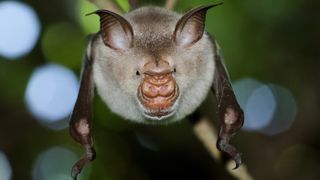Scientists have discovered six entirely new coronaviruses lurking in bats in Myanmar.

These viruses are in the same family as the SARS-CoV-2 virus that is currently spreading across the globe; but the researchers said the newbies aren't closely related genetically to SARS-CoV-2 or to the two other coronaviruses that cause severe infections in humans — severe acute respiratory syndrome (SARS), which caused the 2002-2003 pandemic, and Middle East respiratory syndrome (MERS).
The researchers discovered the viruses while surveying bats in Myanmar as part of a government-funded program called PREDICT to identify infectious diseases that have the potential to hop from animals to humans. And bats are prime suspects, as the mammals are thought to host thousands of yet-to-be-discovered coronaviruses. SARS-CoV-2, which causes the disease COVID-19, is also thought to have originated in bats before taking up residence in humans, possibly taking a detour through some intermediary host first.
Between 2016 and 2018, they collected hundreds of samples of saliva and guano (or bat poop) from 464 bats from at least 11 different species; they sampled at three locations in Myanmar where humans come into close contact with wildlife due to land use changes and recreational and cultural activities — such as guano harvesting for fertilizer.
"Two of these sites also featured popular cave systems where people were routinely exposed to bats through guano harvesting, religious practices and ecotourism," the researchers wrote in their study published online April 9 in the journal PLOS ONE.
The researchers analyzed genetic sequences from these samples and compared them with genomes of known coronaviruses. The new viruses were found in three bat species: the Greater Asiatic yellow house bat (Scotophilus heathii), where PREDICT-CoV-90 was found; the wrinkle-lipped free-tailed bat (Chaerephon plicatus), which was host to PREDICT-CoV-47 and -82; and Horsfield's leaf-nosed bat (Hipposideros larvatus), which carried PREDICT-CoV-92, -93 and -96.
Further research is needed to understand the potential for these six newfound viruses to move to other species and how they might impact human health, the researchers said.
"Many coronaviruses may not pose a risk to people, but when we identify these diseases early on in animals, at the source, we have a valuable opportunity to investigate the potential threat," study co-author Suzan Murray, director of the Smithsonian's Global Health Program, said in a statement. "Vigilant surveillance, research and education are the best tools we have to prevent pandemics before they occur."
Contact between humans and wildlife is only becoming more prevalent, they noted, adding that the current devastation caused by COVID-19 is just one reminder of how closely human health is linked to such interactions.
"Worldwide, humans are interacting with wildlife with increasing frequency, so the more we understand about these viruses in animals — what allows them to mutate and how they spread to other species –– the better we can reduce their pandemic potential," lead study author Marc Valitutto, former wildlife veterinarian with the Smithsonian's Global Health Program, said in the statement.
Originally published on Live Science.

